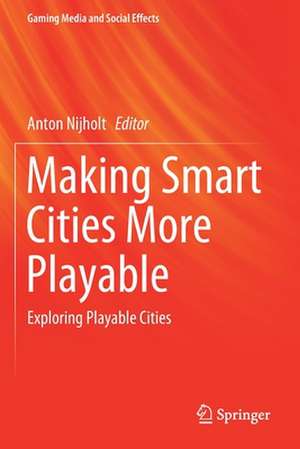Making Smart Cities More Playable: Exploring Playable Cities: Gaming Media and Social Effects
Editat de Anton Nijholten Limba Engleză Paperback – 14 aug 2020
This is a follow-up to another book on Playable Cities edited by Anton Nijholt and published in 2017 in the same book series, Gaming Media and Social Effects.
| Toate formatele și edițiile | Preț | Express |
|---|---|---|
| Paperback (1) | 1048.72 lei 6-8 săpt. | |
| Springer Nature Singapore – 14 aug 2020 | 1048.72 lei 6-8 săpt. | |
| Hardback (1) | 1054.97 lei 6-8 săpt. | |
| Springer Nature Singapore – 2 aug 2019 | 1054.97 lei 6-8 săpt. |
Preț: 1048.72 lei
Preț vechi: 1310.89 lei
-20% Nou
Puncte Express: 1573
Preț estimativ în valută:
200.67€ • 210.08$ • 166.04£
200.67€ • 210.08$ • 166.04£
Carte tipărită la comandă
Livrare economică 05-19 aprilie
Preluare comenzi: 021 569.72.76
Specificații
ISBN-13: 9789811397677
ISBN-10: 9811397678
Pagini: 377
Ilustrații: XI, 377 p. 124 illus., 119 illus. in color.
Dimensiuni: 155 x 235 mm
Greutate: 0.55 kg
Ediția:1st ed. 2020
Editura: Springer Nature Singapore
Colecția Springer
Seria Gaming Media and Social Effects
Locul publicării:Singapore, Singapore
ISBN-10: 9811397678
Pagini: 377
Ilustrații: XI, 377 p. 124 illus., 119 illus. in color.
Dimensiuni: 155 x 235 mm
Greutate: 0.55 kg
Ediția:1st ed. 2020
Editura: Springer Nature Singapore
Colecția Springer
Seria Gaming Media and Social Effects
Locul publicării:Singapore, Singapore
Cuprins
Notă biografică
Anton Nijholt studied mathematics and computer science at the Technical University of Delft, the Netherlands and received a Ph.D. in theoretical computer science from the Vrije Universiteit, Amsterdam, in 1980. Currently a Professor of Computer Science in the Human Media Interaction Group, University of Twente, Enschede, the Netherlands, he has held previous positions at various universities in the Netherlands and abroad.
His main research interests are in entertainment computing, multimodal interaction, affective computing, and brain–computer interfacing. He has produced hundreds of scientific publications, including (edited) books on the history of computing, language processing, and brain–computer interfacing. Recently he has edited two books: Playable Cities and Brain Art, both with Springer. He has been a Guest Editor for Journal on Multimodal User Interfaces, International Journal of Arts and Technology, Entertainment Computing, International Journal of Creative Interfaces and Computer Graphics (IJCICG) and Brain–Computer Interfaces. In addition, Professor Nijholt has served as Program Chair and General Chair for the leading international conferences on affective computing, multimodal interaction, virtual agents, and entertainment computing.
His main research interests are in entertainment computing, multimodal interaction, affective computing, and brain–computer interfacing. He has produced hundreds of scientific publications, including (edited) books on the history of computing, language processing, and brain–computer interfacing. Recently he has edited two books: Playable Cities and Brain Art, both with Springer. He has been a Guest Editor for Journal on Multimodal User Interfaces, International Journal of Arts and Technology, Entertainment Computing, International Journal of Creative Interfaces and Computer Graphics (IJCICG) and Brain–Computer Interfaces. In addition, Professor Nijholt has served as Program Chair and General Chair for the leading international conferences on affective computing, multimodal interaction, virtual agents, and entertainment computing.
Textul de pe ultima copertă
This book explores the ways in which the broad range of technologies that make up the smart city infrastructure can be harnessed to incorporate more playfulness into the day-to-day activities that take place within smart cities, making them not only more efficient but also more enjoyable for the people who live and work within their confines. The book addresses various topics that will be of interest to playable cities stakeholders, including the human–computer interaction and game designer communities, computer scientists researching sensor and actuator technology in public spaces, urban designers, and (hopefully) urban policymakers.
This is a follow-up to another book on Playable Cities edited by Anton Nijholt and published in 2017 in the same book series, Gaming Media and Social Effects.
Caracteristici
Includes chapters on location-based entertainment and games, game-based and public sharing of affective experiences, and game-based social services Addresses outdoor play for children in natural environments, what can be learned from traditional play, and how biodiversity awareness can be enhanced in urban environments, not only for children Critically reviews commercial playable city initiatives; the McDonaldization, the Disneyization, the gamification, and the privatization of public spaces; and the Googleization of smart city services














